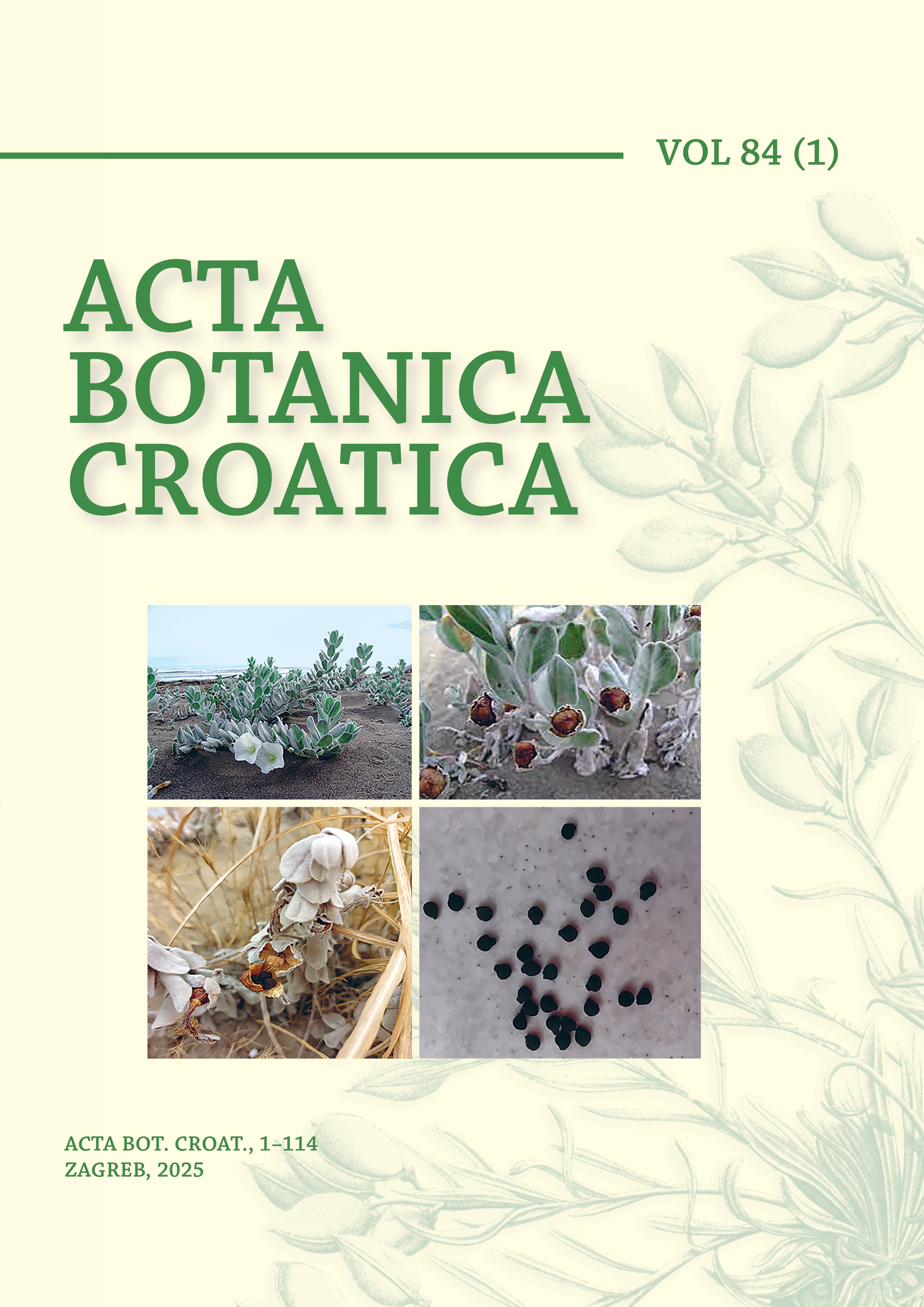Main Article Content
Abstract
We report the first record of Pisutiella phaeothamnos (Kalb & Poelt) S.Y. Kondr., Lőkös & Farkas in the western Mediterranean (Central Spain). The nearest previous records were from the Canary Islands and Greece. The species was discovered among mosses on volcanic rocks in the Spanish Central Volcanic Region. This finding represents a significant expansion of its distribution range.
Keywords
Article Details
Copyright (c) 2024 Gregorio Aragón, Valerie Negrón García, Gil Fernando Giménez

This work is licensed under a Creative Commons Attribution 4.0 International License.
Acta Botanica Croatica is an Open Access journal with minimal restrictions regarding content reuse. Immediately after publishing, all content becomes freely available to anyone for unlimited use and distribution, under the sole condition that the author(s) and the original source are properly attributed according to the Creative Commons Attribution 4.0 International License (CC BY 4.0).
CC BY 4.0 represents the highest level of Open Access, which maximizes dissemination of scholarly work and protects the rights of its authors. In Acta Botanica Croatica, authors hold the copyright of their work and retain unrestricted publishing rights.
By approving final Proof the authors grant to the publisher exclusive license to publish their article in print and on-line, in accordance with the Creative Commons Attribution (CC-BY-4.0) license.
Introduction
Pisutiella phaeothamnos (Kalb & Poelt) S.Y. Kondr., Lőkös & Farkas (= Caloplaca phaeothamnos Kalb & Poelt) is a muscicolous species growing amongst moss (primarily Grimmia spp.) on base-rich volcanic rocks under arid or semiarid environmental conditions (Malíček et al. 2021). The known distribution range of the species extends to a few localities in Türkiye (Poelt and Kalb 1985, Vondrák et al. 2012), Greece (Malíček et al. 2021), Iran (Sohrabi and Sipman 2020) and the Canary Islands (Hafellner 1995). Herein, we document the first record of Pisutiella phaeothamnos in the Iberian Peninsula, thereby broadening its known range to encompass the southwestern region of Europe (Fig. 1).
Figure 1.
Fig. 1. Global distribution of Pisutiella phaeothamnos. White cross: the new localities. Scale bar = 1000 km (derived and adapted from Google Earth).
Material and methods
Specimens were collected in 2023 and 2024, in the volcanic area “Campo de Calatrava” in Mediterranean Spain. The samples were deposited in the MACB Herbarium (Faculty of Biology, Complutense University of Madrid). The nomenclature followed the Index Fungorum Partnership (2024).
Localities of sampling: Spain: Ciudad Real province, Ballesteros de Calatrava, la Conejera, 38°48'0.2''N, 3°56'20.5''W, 830 m a.s.l., among mosses on volcanic rocks, G. Aragón & G. F. Giménez, n° 1566, November 16, 2023, MACB. Ciudad Real province, Almagro, Granátula de Calatrava, Cerro Gordo, 38°49'51.8''N, 3°44'23''W, 785 m a.s.l., G. Aragón, G. F. Giménez & V. Negrón, n° 1610, January 29, 2024, MACB.
Results and discussion
Pisutiella phaeothamnos is distinguishable from other crustose species of Caloplaca s. l. by the brown, minutely fruticulose thallus composed of branched lobes (4–5 mm tall), K–, ochraceous brown to orange apothecia (Fig. 2), and its ellipsoid and polarilocular spores of (7) 9–10 (11) × (4) 5–6 µm, and septum 3 µm wide. A comprehensive description of the species is documented in Poelt and Kalb (1985).
Figure 2.
Fig. 2. Pisutiella phaeothamnos. A – volcanic rocks in “Cerro Gordo”, B – P. phaeothamnos among mosses in volcanic rock (scale bar = 1 cm), C – ochraceous brown apothecia (scale bar = 2 mm), D – minutely fruticulose thallus (scale bar = 2 mm) (Photo: G. Aragón).
The species grows among bryophytes (Grimmia decipiens (Schultz) Lindb.) on volcanic rocks, under dry and sunlit conditions, at elevations ranging from 750 to 850 meters (Fig. 2). It is found on moderately inclined surfaces together with Caloplaca stillicidiorum (Vahl) Lynge and small thalli of Cladonia foliacea (Huds.) Willd. and Protoparmeliopsis bolcana (Pollini) Lumbsch, which partially cover the bryophyte surface (Fig. 2).
The habitat was similar to that previously reported for Pisutiella phaeothamnos. The species appears solely amongst mosses in volcanic rocks at altitudes of 500–1700 m a.s.l. in Eastern Europe (Poelt and Kalb 1985, Vondrák et al. 2012, Malíček et al. 2021) and at elevations from 1500 to 1850 m a.s.l. in the Canary Islands (Hafellner 1995).
The new site is located within a vast volcanic region in central Spain, about 5,000 square kilometers in area (Becerra-Ramírez et al. 2020). The volcanic formations resulted from low-explosivity events dated to between 700,000 and 800,000 years ago and are primarily composed of alkaline rocks from the basalt series (Becerra-Ramírez et al. 2020). The predominant land use in this area is extensive agriculture of cereals, olive and almond trees, and sheep livestock management (Becerra-Ramírez et al. 2020).
Pisutiella phaeothamnosis reported here from SW Europe for the first time and its distribution area is now enlarged to include the Iberian Peninsula (Fig. 1). The nearest locality is situated in the Canary Islands (Hafellner1995).
References
Becerra-Ramírez, R., Gosálvez, R. U., Escobar, E., González, E., Serrano-Patón, M., Guevara, D., 2020: Characterization and geotourist resources of the Campo de Calatrava Volcanic Region (Ciudad Real, Castilla-La Mancha, Spain) to develop a UNESCO global geopark project. Geosciences 10(11), 441. https://doi.org/10.3390/geosciences10110441
Hafellner, J., 1995: Bemerkenswerte Funde von Flechten und lichenicolen Pilzen auf makaronesischen Inseln III. Einige bisher auf den Kanarischen Inseln übersehene lecanorale Arten. Linzer Biologische Beiträge 27, 489–505.
Malíček, J., Bouda, F., Konečná, E., Sipman, H., Vondrák, J., 2021: New country records of lichenized and non-lichenized fungi from Southeastern Europe. Herzogia 34(1), 38–54. https://doi.org/10.13158/heia.34.1.2021.38
Poelt, J., Kalb, K., 1985: Die Flechte Caloplaca congrediens und ihre Verwandten: Taxonomie, Biologie und Verbreitung. Flora 176, 129–140.
Sohrabi, M., Sipman, H., 2020: An updated checklist of the lichenized and lichenicolous fungi of Arasbaran, UNESCO-Man and Biosphere Reserve, Northwest of Iran. Mycologia Iranica 7(1), 45–62. https://doi.org/10.22043/mi.2020.122654
Vondrák, J., Halici, M. G., Kocakaya, M., Vondráková, O., 2012: Teloschistaceae (lichenized Ascomycetes) in Turkey. 1. Some records from Turkey. Nova Hedwigia 94(3–4), 385–396. https://doi.org/10.1127/0029-5035/2012/0007

